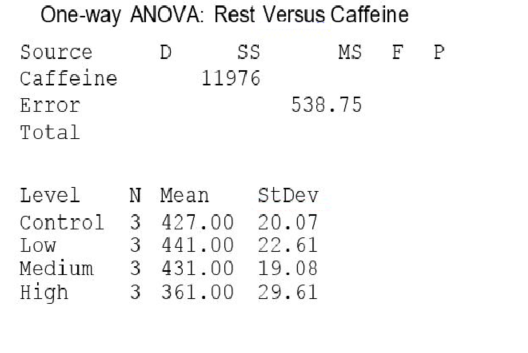Investigators gave caffeine to fruit flies to see if it affected their rest. The four treatments were a control, a low caffeine dose of 1 mg/ml of blood, a medium dose of 3 mg/ml of blood, and a higher caffeine dose of 5 mg/ml of blood. Twelve fruit flies were assigned at random to the four treatments, three to each treatment, and the minutes of rest measured over a 24-hour period were recorded. Assume the data that follow are four independent SRSs (one from each of the four populations of caffeine levels) and that the distribution of the yields is Normal.  A partial ANOVA table produced by Minitab follows, along with the means and standard deviation of the yields for the four groups.
A partial ANOVA table produced by Minitab follows, along with the means and standard deviation of the yields for the four groups.  For this example, we notice that:
For this example, we notice that:
Definitions:
Electroconvulsive Therapy
A psychiatric treatment in which seizures are electrically induced in patients to provide relief from mental disorders.
Electrical Current
The flow of electric charge carried by electrons moving through a conductor, measured in amperes.
Negative Thought
A thought that is usually pessimistic, critical, or self-defeating, often contributing to feelings of distress.
Aaron Beck
An American psychiatrist who is known as the father of cognitive therapy, focusing on changing clients' patterns of thinking to reduce negative emotions.
Q4: In determining the adequacy of the allowance
Q8: Veterinarians often use nonsteroidal anti-inflammatory drugs to
Q14: Which of the following is NOT a
Q17: Scores on the SAT verbal test in
Q17: Most of the transactions in the production
Q21: A high-profile consulting company chooses its new
Q23: When evaluating the results of substantive audit
Q39: In order to investigate treatments for morbid
Q109: Which of the following two effects of
Q183: Which of the following is correct?<br>A) No